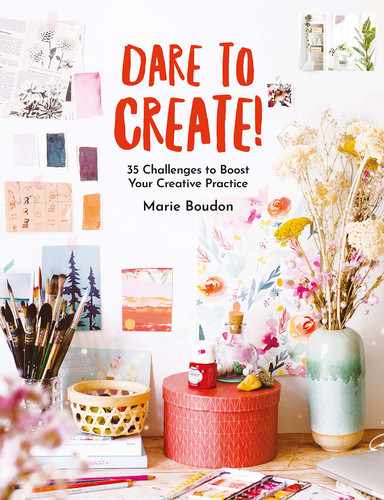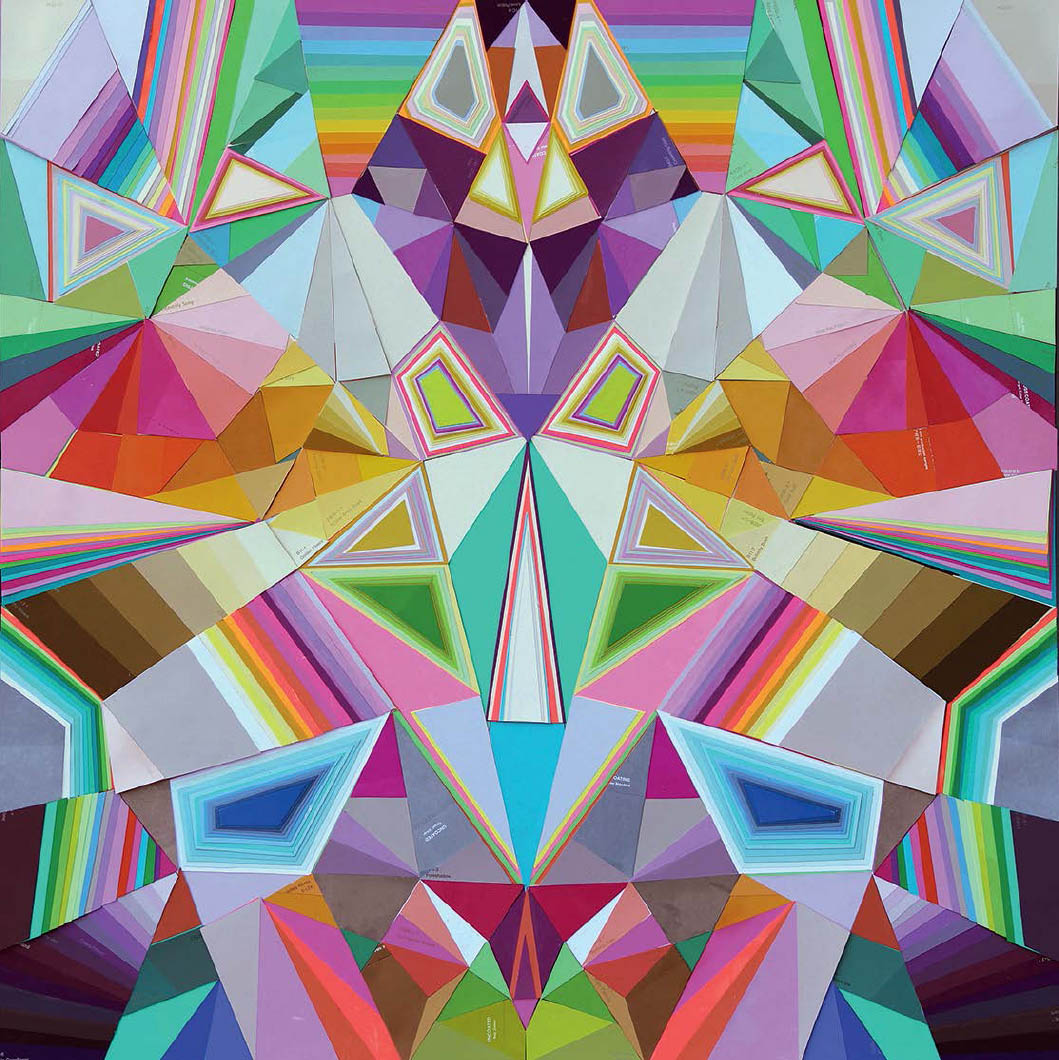 CHALLENGE 7
CHALLENGE 7 
Accepting your beginner status
YOU KNOW NOW THAT, IN ORDER TO MOVE FORWARD IN YOUR CREATIVE ADVENTURE, YOUR MENTAL SPACE IS AT LEAST AS IMPORTANT AS YOUR ARTISTIC ABILITIES, IF NOT MORE SO. THE WAY YOU LOOK AT FAILURES, IN PARTICULAR, IS KEY. CONQUER YOUR SELF-DOUBTS AND DISAPPOINTMENTS AND GIVE YOURSELF PERMISSION TO BE A BEGINNER IN ORDER TO MAKE YOUR PRACTICE SUSTAINABLE. THIS CHALLENGE WILL HELP YOU DO THAT IN TWO WAYS: BY THINKING ABOUT YOUR ABILITY TO TOLERATE MISTAKES AND BY STARTING NEW NOTEBOOKS.
Being patient with yourself
Giving yourself permission to be a beginner means accepting the mistakes, confusion, and qualms that go along with the first experiments in a creative activity. Being in this state of mind will be very helpful to you, even if you are experienced, but it is not always easy to get there. Your expectations are probably very high because you are comparing yourself with other people. And watch out, because a disappointment early on can unfortunately spell the end of a budding artistic practice.
Accept the fact that everything has to start somewhere. Reaching your creative goal may take six months, a year, or ten years. Prepare your ego to tolerate this waiting period. In a society where everything goes very fast, where everything is just a click away, our egos look for immediate gratification—but the creative process is slow. The best way to overcome difficulties is, therefore, to accept them from the start. Expect failures and accept them, because they are an integral part of every practice. Find satisfaction in the effort that you make rather than in the result. “I didn’t do anything worthwhile today” then becomes “I am thrilled that I drew today.”
Almost two years of practice in watercolors are in this stack of papers, and a lot of failures. All the better!
Celebrating mistakes
Mistakes are not just part of the creative process; they are actually helpful to that process.
Noticing that something isn’t working allows you to better understand the operation involved, the problem, or the technique. Allow yourself to make mistakes so that you can improve. It is by recognizing your failures, not letting them be too important, and not trying to avoid them at all costs that you will be able to make fewer of them tomorrow.
Matisse, in Chatting with Henri Matisse: The Lost 1941 Interview (with Pierre Courthion), explains: “When you’re a student, you are focused on only one thing: not making mistakes. That’s very bad. You can see mistakes. But it’s harder to see the positive things. They are less clear-cut. You don’t want to make mistakes . . . we hold ourselves in check too much. But over time, one makes up for it! At least I have.”
Mistakes push us to take risks so that we can try to fix them. They can also be the starting point for a reflection that might finally make you change your mind and come to love a “failure.” Thus, a mistake can become a happy accident, the beginning of a project, or an integral part of the development of your artistic identity. Matisse, for example, replaced values with color contrasts. What could have been seen as a mistake when he started out became one of his strengths. Transform your difficulties into opportunities. A mistake can become an asset, if you look at it from the right angle. Atmosphere, personality, colors, movement, contrast, energy: there will always be something missing from your artwork for someone, no matter what kind of art you make. So don’t try to please everyone, and don’t be so critical of yourself.
Spotlight on Josie Lewis
“Making mistakes is essential for improving your art and watching your style emerge. Taking risks is also necessary in order to have an impact, even a small one, on the world. By taking a lot of risks and making a lot of mistakes, we learn; and finally, failing is not such a big deal. Mistakes do not define us. It’s just a piece of information, it does not make us good-for-nothings. We should have a sense of humor about the risks we take in our practice. If something isn’t working, we should say to ourselves: ‘Oh, that didn’t work. What should I do now?’”
See Josie’s story on page 93.
Ladder by Josie Lewis, collage on wood, 76 x 76 cm, 2017
Getting beyond fear
There are generally three reasons for trying to avoid making mistakes.
First of all, you might be a perfectionist. If that is the case, then reread the suggestions above so that you can learn to accept mistakes, or read challenge 32 if you are really stuck.
Secondly, you may have so little time to give to your creativity that when you create, you feel like it has to be a success right away. In that case, I would suggest that you balance your technical practice (part 4) with playful phases (challenge 19) as well as experimental ones (challenges 26 and 27). Also read Minnie Small’s story, she ran into this same problem (page 150).
And finally, you may be afraid of wasting your materials (paints, paper, canvas, etc.), and you’d rather just keep admiring your collection than touch it.
In each of these cases, I would suggest that you use several inexpensive notebooks that can serve a number of purposes:
![]() warmup or draft notebook: to help you relax when you start a creative session.
warmup or draft notebook: to help you relax when you start a creative session.
![]() test notebook: to improve your technique, try out new things, make sketches (challenge 23), and experiment (challenge 26).
test notebook: to improve your technique, try out new things, make sketches (challenge 23), and experiment (challenge 26).
![]() final draft notebook: your “perfect notebook,” so to speak. For me, this kind of a notebook represents too much pressure, but it might be right for you, in combination with a warmup notebook.
final draft notebook: your “perfect notebook,” so to speak. For me, this kind of a notebook represents too much pressure, but it might be right for you, in combination with a warmup notebook.
![]() idea box (challenge 10): this can be combined with an observation journal (challenges 11 and 12) and a research notebook (challenge 22).
idea box (challenge 10): this can be combined with an observation journal (challenges 11 and 12) and a research notebook (challenge 22).
![]() just-for-fun notebook (challenge 19): not for thinking about the result, but just taking advantage of your art supplies.
just-for-fun notebook (challenge 19): not for thinking about the result, but just taking advantage of your art supplies.
You can also just use one notebook that has everything in it: there aren’t any rules. Don’t be afraid to have disorganized notebooks, and to open them to random pages to avoid overthinking things. If there is a page that you don’t like and that is keeping you from continuing to use the notebook, tear it out or cover it up.
![]() Your Turn
Your Turn ![]()
In order to help prepare yourself to get better at accepting your mistakes:
- 1. Take the time for some introspection and think about how you react to mistakes. Is it easy for you to accept them? Do they challenge your perfectionist tendencies and make it hard for you to move forward? Can you give yourself permission to be a beginner? In your creative journal, write down how you feel in response to the question.
- 2. Even though your schedule might be tight, think about balancing technical practice with more experimental phases (which will also be more likely to produce mistakes). You will find more specifics about how to do that in part 5, “Expressing Yourself.”
- 3. If it is relevant to your discipline, have you thought about using one or more notebooks to overcome your perfectionism? Draw from the suggestions in this challenge to get started in a notebook where you will be allowed to make mistakes.



